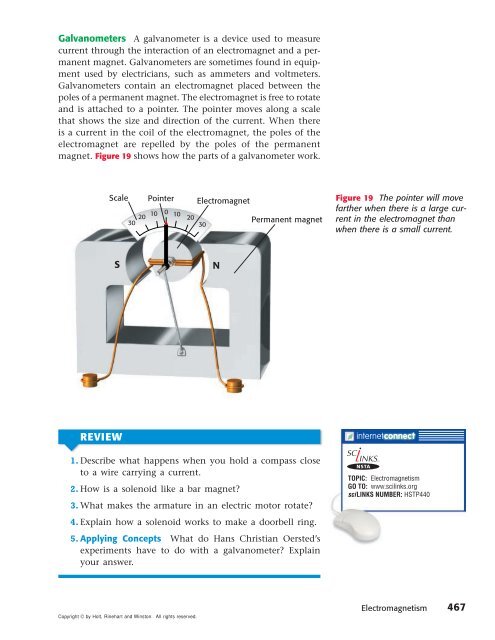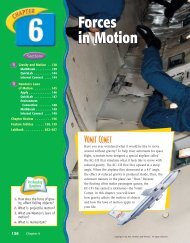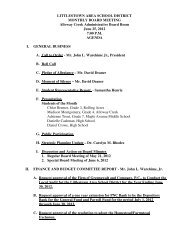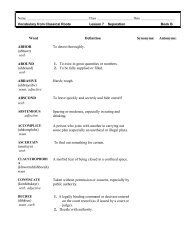Electromagnetism Electromagnetism
Electromagnetism Electromagnetism
Electromagnetism Electromagnetism
Create successful ePaper yourself
Turn your PDF publications into a flip-book with our unique Google optimized e-Paper software.
Galvanometers A galvanometer is a device used to measure<br />
current through the interaction of an electromagnet and a permanent<br />
magnet. Galvanometers are sometimes found in equipment<br />
used by electricians, such as ammeters and voltmeters.<br />
Galvanometers contain an electromagnet placed between the<br />
poles of a permanent magnet. The electromagnet is free to rotate<br />
and is attached to a pointer. The pointer moves along a scale<br />
that shows the size and direction of the current. When there<br />
is a current in the coil of the electromagnet, the poles of the<br />
electromagnet are repelled by the poles of the permanent<br />
magnet. Figure 19 shows how the parts of a galvanometer work.<br />
REVIEW<br />
Scale Pointer Electromagnet<br />
S<br />
20<br />
10 0 10<br />
20<br />
30 30<br />
1. Describe what happens when you hold a compass close<br />
to a wire carrying a current.<br />
2. How is a solenoid like a bar magnet?<br />
3. What makes the armature in an electric motor rotate?<br />
4. Explain how a solenoid works to make a doorbell ring.<br />
5. Applying Concepts What do Hans Christian Oersted’s<br />
experiments have to do with a galvanometer? Explain<br />
your answer.<br />
Copyright © by Holt, Rinehart and Winston. All rights reserved.<br />
N<br />
Permanent magnet<br />
Figure 19 The pointer will move<br />
farther when there is a large current<br />
in the electromagnet than<br />
when there is a small current.<br />
NSTA<br />
TOPIC: <strong>Electromagnetism</strong><br />
GO TO: www.scilinks.org<br />
sciLINKS NUMBER: HSTP440<br />
<strong>Electromagnetism</strong> 467





